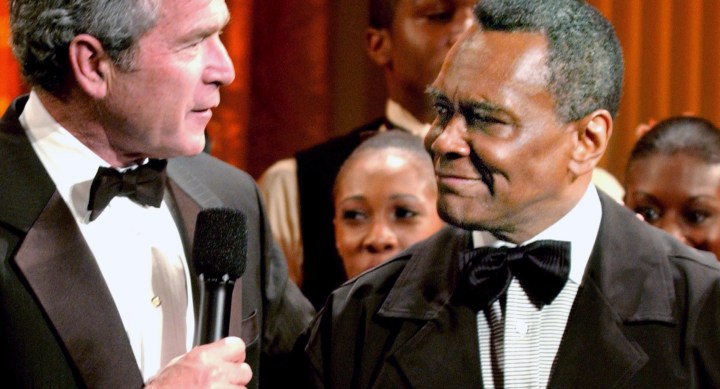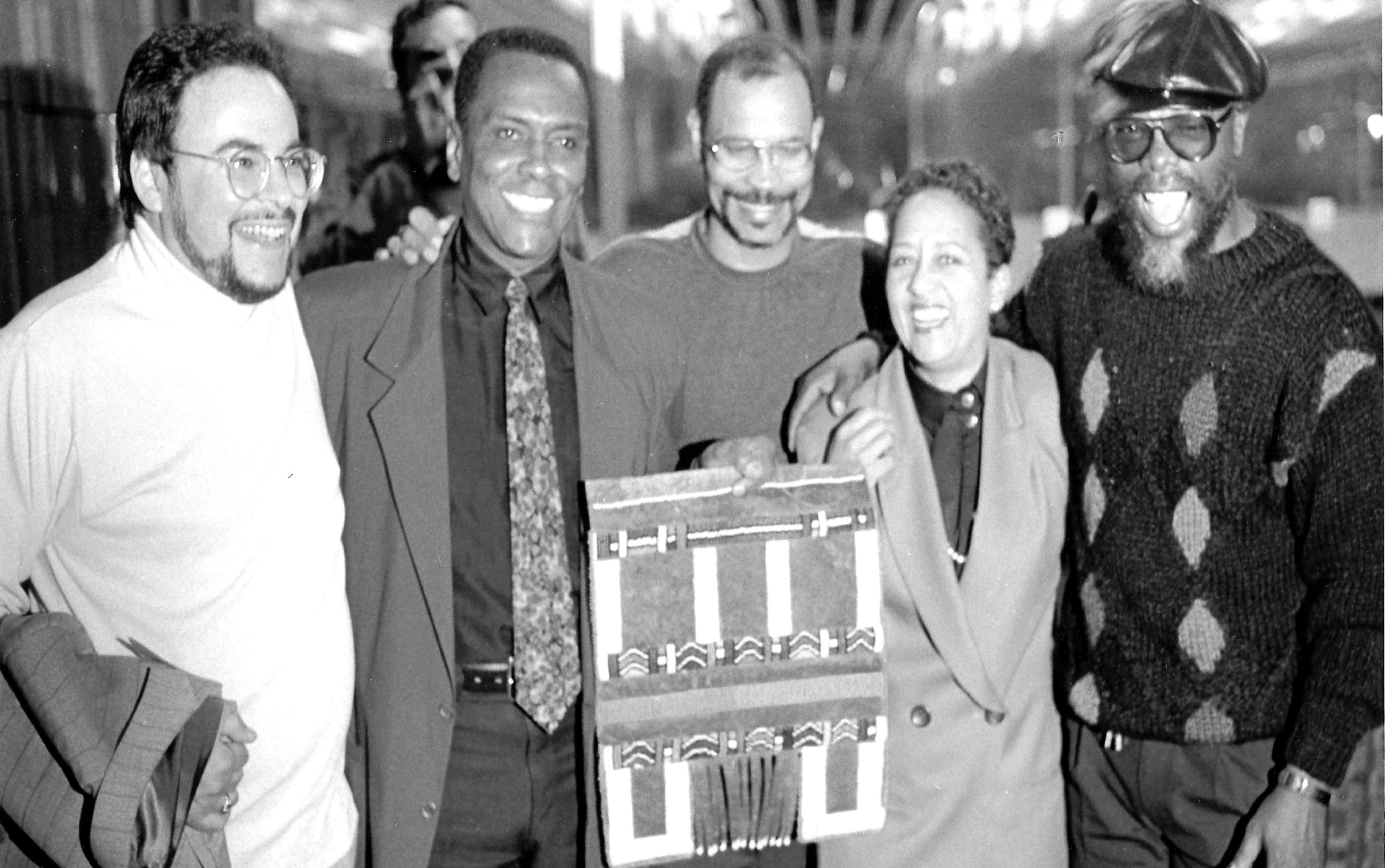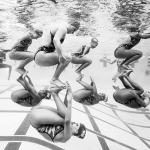Arthur Mitchell, 1934 – 2018
Requiem for an African-American Dream come true

Legendary dancer, choreographer, teacher, barrier breaker Arthur Mitchell changed ballet forever and broke barriers for African-American dancers. His Dance Theatre of Harlem’s unprecedented tour to South Africa became an international news event as well as the first major cultural group to visit South Africa and mark the end of the cultural boycott.
After a lifetime of firsts, Arthur Mitchell passed away on 19 September at the age of 84. He had been a celebrity star dancer for George Balanchine’s New York City Ballet, with dances choreographed for him; he had been a global exponent of ballet as a tool for cultural exchange and changing attitudes; he had founded the Dance Theatre of Harlem as a personal response to his anguish after the death of Martin Luther King, and he had led the first major cultural group to visit South Africa as a compelling symbol that the old apartheid order was over – and that a new nation was being born. And, of course, in all this he had been a black man, from distinctly humble origins (his father had been a building maintenance super), who had accomplished all of this.
As a young child, he sang in a Police Athletic League glee club and in the Convent Avenue Baptist Church choir, and he had some rudimentary tap classes at his neighbourhood schools. But his first exposure to formal dance classes had only come after his junior high school guidance counsellor had seen him dancing at a school class party, and then encouraged him to audition for the High School of Performing Arts in Manhattan, the school depicted in the film, Fame. He stood out as a student and was soon performing with the school’s modern-dance ensemble and even trying out his own choreography.
He even had chances to perform in Europe, including being cast in the role of an angel in the 1952 revival of the avant-garde Virgil Thomson-Gertrude Stein opera Four Saints in Three Acts in both New York and Paris. (Back at its original composition, the composer and librettist had stipulated that the cast had to be an all-black one whenever that work was performed.) From the Fame School, it was then on to the outrageously selective School of American Ballet. From there it was then a jump to George Balanchine’s globally renowned company, where he eventually rose to become a principal dancer. Along the way, Mitchell worked with Broadway, modern dance projects, and almost every other opportunity that came along.
After Mitchell had become an established lead dancer in the New York City Ballet, Balanchine choreographed works to make best use of Mitchell’s lithe athleticism, as he did with the very abstract-styled pas de deux in Agon.
Watch: Agon Pas de Deux:
Then, in A Midsummer Night’s Dream, Mitchell’s Puck was a legendary triumph in which he almost seemed to defy gravity.
Watch Mitchell’s Puck:
Agon was a cause celebre that transcended the rather rarefied atmosphere of ballet at the time. The angularity of the dancing was one thing, but it also paired a muscular black man with a white female dancer who touched on stage in ways many ballet fans had not expected to see, not even in New York City, back in the early 1960s:
Speaking about George Balanchine’s audacity in casting Mitchell in the lead in Agon, Mitchell had told friends later”
“Can you imagine the audacity to take an African-American and Diana Adams, the essence and purity of Caucasian dance, and to put them together on the stage? Everybody was against him. He [Balachine] knew what he was going against, and he said, ‘You know, my dear, this has got to be perfect.’ ”
And it was.
Five years after Agon, Balanchine then created that role of Puck for Arthur Mitchell, turning him into a high-flying, hard-dancing, naughty spirit in A Midsummer Night’s Dream. Ballet critic Walter Terry had written of Mitchell’s portrayal that Mitchell had danced “as if he were Mercury subjected to a hotfoot”.
Mitchell became involved in establishing a national ballet in Brazil at the invitation of the US State Department, and in 1968, while he was on the way to board a plane for a visit there, he had heard on the radio of the death of Rev Martin Luther King Jr and the outbreaks of violence and rioting that quickly followed. Right then and there, Mitchell had resolved to do something to reach out to African-American youth in order to find a better course of action for such young people.
Working with his long-time friend and professional dance mentor Karel Shook, Mitchell opened his new school, aimed at young black Americans in New York City. This new ballet school started with a mere handful of curious children, but within a few months, there were hundreds of eager young hopefuls. In that transition period in his professional life, one of the last ballets Mitchell performed with the New York City Ballet, before moving on full time with his own dreams, had been Balanchine’s Requiem Canticles, a tribute to Rev King, created shortly after he had been assassinated in 1968.
Back when Mitchell had first opened his school, and then, thereafter, as he established the professional company known as the Dance Theatre of Harlem, there had been an unwritten but rather obvious code about the correct physiognomy for female ballet dancers. They all had to present the same willowy proportions, they had to be the same height to deliver the right visuals to the audience – and, of course, they had to be white. Male dancers could vary a bit, just as Mitchell had himself done, but that awkward business about skin colour was always in the mix.
Mr Mitchell’s Dance Theatre of Harlem changed all of this. Even Dance Theatre of Harlem’s signature works such as Dougla by Geoffrey Holder that depicted a rowdy Trinidadian Afro-South Asian marriage, the Dance Theatre of Harlem could deliver a gutsy, athletic spectacle that left audience members literally gasping for breath, right along with a few of the dancers.
Still, in all of the Dance Theatre of Harlem’s performances, the programmes were always set up in accordance with Arthur Mitchell’s famous maxim that every performance should have an appetiser (a starter), a main course, and a dessert – designed to cater to different tastes and to enhance appreciation for dance. While it was true some of the showier works such as Dougla might be more modern dance than ballet, John Tara’s Firebird to the Igor Stravinsky score, and choreographed specifically for the Dance Theatre of Harlem, was presented by the company for years. The work made a deep bow towards the original choreography, yet was new, fresh, and different, and it became an instant hit with audiences worldwide and was a standard of the company’s repertory for decades.
The Dance Theatre of Harlem grew rapidly in prominence in America as an early symbol of a growing racial integration of “high culture”, and Mitchell’s company and the school became avenues through which a growing roster of black classical ballet dancers could live their hopes that they too could achieve their professional goals.
Moreover, under Arthur Mitchell’s guidance, the company continued to add a growing range of classical ballet works and neo-classical ones, as well as specially commissioned material, sometimes with an American (and African-American) theme, such as John Henry, choreographed by Mitchell on the legendary railroad worker’s life and apotheosis. Classical productions were carefully tailored to suit and show off his black dancers, with costumes designed to flatter the variety of skin tones of those very dancers. In his restaging of Giselle, for example, he repositioned the ballet’s story to 19th-century Louisiana, with Creole characters, and the setting of Firebird became a lush jungle, instead of the forest of the original Fokine plan.
As the company gained international recognition, it began to tour internationally, and, in 1989, the State Department reached out to the company to visit to the Soviet Union as the first American cultural group to travel there since the freeze in cultural ties occasioned by the Soviet invasion of Afghanistan. Their growing global reputation as first tier cultural ambassadors was locked as a result of the success of that trip.
Meanwhile, this writer had just arrived in South Africa for a second official assignment, this time as cultural attaché for the US Embassy. It turned out that 1989 also marked the moment the great freeze of apartheid really began to come undone; first as the initial political prisoners were released towards the end of the year, and then, in early 1990, as the much more general movement began in earnest, with the release of Nelson Mandela and the unbanning of political groups. At that point, in our office we suddenly had to consider just what, exactly, our role would be in dealing with a South African landscape that would be very different from what it had been, just a few months previously. There were now possibilities for the reopening of academic and cultural relations, long dormant. But if that would become possible, what kind of group was the right one to bring to such a nation?
As it happened, I had just seen a cover story in a major US magazine about that trip to the Soviet Union by the Dance Theatre of Harlem. Doing a bit of research, I learned the company had three black South Africans among its dancers – August van Heerden, Felicity de Jager, and Laveen Naidu. More happy coincidences awaited. Van Heerden had studied dance with my wife, a South African, when they were younger; and my wife’s mother had had a hand in training De Jager as well. All three dancers had never had the opportunity to perform professionally in South Africa.
By this time, the political climate had moved sufficiently that we could open a dialogue, initially via Van Heerden, with the Dance Theatre of Harlem and Arthur Mitchell – who was intrigued by the possibilities. But before they would get on the plane and fly to Africa, they required formal support from the ANC, the PAC and Azapo, a buy-in by the UN’s Special Committee on Apartheid, an actual invitation to perform issued by a legitimate local sponsor, and a suitable venue in which they could perform. The Dance Theatre of Harlem and Mitchell had international regard, a special status in the US, and a truly unique position within the African-American community as well, and they were not about to compromise any of that in a trip to South Africa that was guaranteed to be a major news story internationally.
As a first stop, I sought the agreement, in principle, from the Market Theatre, internationally recognised for its place within the cultural universe for its no-holds-barred protest theatre activities. Simultaneously, we made representations to the various liberation movements, now legitimately operating inside the country – which we actually received. And we looked for someone to help financially. Fortunately, a major South African bank agreed to bear some of the costs. But then the city discovered that its newly renovated Civic Theatre (now the Joburg Theatre) had no opening programme for its theatre because of its past ties to apartheid structures and activities. (The offer of the Dance Theatre of Harlem in exchange for a revamping of its management board was requested and carried out with alacrity.) Eventually, Arthur Mitchell’s own magnetism carried the day with the UN and the visit began to come together, despite concerns about who would (or could) come to see the programme and how the company would be engaged with South Africa’s larger society.

Picture: Arthur Mitchell, head of the Dance Theatre of Harlem, on arrival in South Africa at the then-Jan Smuts Airport, September 1992. Left to right: the author, Arthur Mitchell, Augustus van Heerden (dance master of the Dance Theatre of Harlem company), Ruth Jacobs Spector (author’s spouse), and John Kani (representing the Market Theatre Foundation).
By the time the company had finished their month-long trip to South Africa, they had performed to over 10,000 people in the theatre; and some 25,000 people from all over the Witwatersrand – in township halls and dance schools alike – had attended master classes, workshops, lectures, and so much more. After a special invitational evening hosted for the ANC, Nelson Mandela had so praised the evening’s programme that his effusive comments about that night stayed on the Dance Theatre of Harlem’s own publications for years to come.
Following the company’s return to the US, it continued its run of successful tours and performances around the world, although fund-raising eventually ran behind costs, and the company was forced to downsize, regroup and even – for a time – close down its performances and touring. Rebuilding, the school now has some 300 students and the reconstituted company performs again.
A few months ago, when he was asked in an interview with The New York Times what he considered his greatest achievement, Arthur Mitchel had said:
“That I actually bucked society, and an art form that was three, four hundred years old, and brought black people into it.”
And so he did. DM















 Become an Insider
Become an Insider